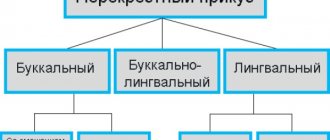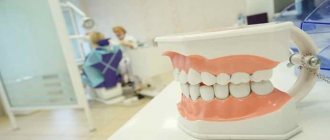Modern orthodontics is aimed at achieving an aesthetic and functional optimum of the dental system as a whole and is part of the comprehensive rehabilitation of patients in dentistry and maxillofacial surgery.
The objectives of orthodontics include: straightening teeth, correcting bites of any complexity, forming a harmonious smile, and correcting the asymmetry of the patient’s face. Effective treatment of patients with dental anomalies requires the participation of a whole team of specialists.
If the teeth are crowded and uneven, based on the results of a consultation with an orthodontist, the patient is treated with special orthodontic devices - braces or aligners.
In cases of patient complaints about facial aesthetics, asymmetry, as well as deep or crossbite, treatment uses an integrated approach, involving the interaction of an orthodontist and a maxillofacial surgeon.
In these clinical cases, preparation for dramatic changes in the aesthetics of the patient’s face and performing maxillofacial orthognathic surgery are required.
Correction of bite in children
What is special about children? The fact is that children are a growing group of patients. Growing patients have high growth potential. What does this mean? The fact that we can influence the growth of one or another segment of the jaw, we can influence the change in bite most effectively, while in adults, since growth has already been completed, we can only actually work with that bite, with that position of the teeth, which is available. Therefore, the prognosis for children is much more favorable, on the one hand. In this material, we will first look at correcting the bite in young children, and at the end we will talk about modern possibilities for correcting the bite in older children, 15-18 years old.
Records
An orthodontic plate is designed to correct the position of one or more teeth in the jaw.
It consists of a palatal plane and a power arc that exerts pressure on certain elements of the dentition.
Dentists recommend using the plate for the following pathologies:
- large gaps between teeth;
- increased crowding of the elements of the jaw line;
- protrusion of some teeth in relation to others.
The advantages of bite correction using plates include their low cost and the absence of discomfort during use.
At the same time, dentists note that such structures are unable to cope with complex anomalies in the location of teeth.
The disadvantages of the plates include the need to use them throughout the day, removing them from the oral cavity only when eating and performing hygiene procedures..
What methods exist for straightening teeth and correcting bites in children?
The first method of straightening teeth in children is the “classic of the genre”, something that was known back in the Soviet Union - these are plates.
What are the advantages of records (there are four of them):
- is that records are relatively cheap to make,
- the fact that children can easily brush their teeth (again, due to the fact that they are removable).
- the third advantage is that there are quite powerful mechanics for correcting the bite, because most often special screws are installed in the plates, which are unscrewed by the parents, that is, which are activated and create the force necessary either to move the teeth or to expand the size of the jaws.
- well, and another fourth plus is that they are produced quite quickly, that is, you don’t have to wait long for them - literally a few days, and the record is ready.
What are the disadvantages of records? There are also four of them:
- The first disadvantage of the plates
is that the plates are quite uncomfortable. The plate is quite bulky - accordingly, the space for the tongue is reduced. It is constantly observed that children play with records: they remove them with their tongues, play around, and so on. Therefore, they are quite inconvenient. - Second minus .
Serious. The records change the perception of taste. This is especially true for the plate on the upper jaw. The fact is that there are taste buds on the hard palate, the plate covers them, and the child, in theory, when undergoing a course of bite correction should walk with the plate constantly, removing it only to brush his teeth. It turns out that when a child eats, the food does not touch the palate, and therefore the sensation of taste changes. It's not very pleasant. - The next, third disadvantage
(I have already partially mentioned this) is that diction is impaired with records due to the fact that they are simply in the space for the tongue. Children adapt quite quickly to records in terms of diction, but still there are definitely residual phenomena, and if, say, we have a schoolchild in front of us, then this creates a lot of inconvenience, for example, from the point of view of sound pronunciation in foreign languages - where teachers are constantly fighting for pure sound pronunciation, for correct diction, and so on. In this regard, the plates are, of course, very inconvenient, and the temptation to take them off during classes and then forget to put them on is very great. - The fourth minus
. And this is also the next minus for parents and doctors, and a plus for children (this is such a plus or minus) - the ability to remove these plates! Yes, this is convenient for hygiene, but from another point of view, children are often guilty of this - when they leave parental control (for example, to school), they take off the records and put them, God willing, in some other box ( or even in your pocket), they walk around all day without the records, everything is fine, and then they put them on again in front of their parents. It turns out that the effectiveness of treatment in correcting a child’s bite in this case is reduced to zero.
Summary of records
So what can I say based on the records? If the child is disciplined, if he wears the plate well, constantly and follows all the doctor’s recommendations, then this is a very good technology, and it can solve certain problems quite quickly. The downside - from all that I have listed - is that if the child is undisciplined or, say, there is low cooperation with him, then in this case the plates are more of a torment than any kind of effectiveness.
Questions and answers about records
- But there is also a moment that even if the child does not wear it partially, it is twisted, expanded, and the parent can notice that it does not go over the teeth if you start to expand it.
- Absolutely right.
- Then see a doctor.
It turns out that there is still some impact on the child in this situation. - No. You see, the fact is that if the child does not wear the plate, then the jaw does not expand properly, as intended in the plate. That is, in this case the plate dangles, as patients sometimes say, it’s like a galosh. It no longer puts pressure on the teeth and does not fit. And in this case, of course, the doctor, for his part, tries to somehow correct it, screw it back, but often this leads to the fact that the plate has to be redone. And these are new investments, we are stalling in one place, and the problem is not being solved. Therefore, the effectiveness of the plate, if you wear it, is high, but, unfortunately, there are a lot of such “victims” who did not wear the plate, and then they come at an older age.
Composite restoration
Restoration of teeth using composite material allows you to restore the shape of the elements of a row in case of various chips and destructions.
After preparing an incisor or molar, a special reflective composition identical to enamel is applied to it. After grinding and polishing, the restored tooth is practically no different from the rest.
The advantages of the method include its accessibility, aesthetics and quick effect. Among the disadvantages are the possibility of darkening of the composite material and a short service life.
The cost of tooth restoration using this method starts from 600 rubles and reaches 4000 rubles, depending on the manufacturer of the composite composition.
The second option for correcting malocclusion in children is elastopositioners.
Elastic positioners are a whole group of aligners. They are devices made of silicone. In appearance, they resemble boxing splints that athletes wear.
– Are these so-called myofunctional trainers?
– Yes, that’s absolutely right. You see, a trainer is more of a “proper name”, that is, a certain company has such devices that are called “trainers”. They can, of course, be called trainers, but it seems to me that it would be better to call them “elastic positioners”. That is, this is more of a collective name. What's the point? The fact is that these devices are made in an ideal bite, in the correct bite. Some of them have cells for the correct position of the teeth, that is, they work as guides. Some do not have these cells. But the point is that the elastopositioner, when worn by a child, trains the muscles to put the lower jaw in the correct position. As you know, our upper jaw is fixedly welded to the skull, it is impossible to move it, that is, the lower jaw, in fact, is responsible for the bite, how it relates to the upper jaw. And the position of the lower jaw is often determined by the condition of the muscles, because it is suspended by the muscles. And thus, elastopositioners work with muscles, they train the muscles to put the lower jaw in the correct position. The wearing mode is as follows for elastopositioners, the main recommendations are: two hours during the day and be sure to sleep in the trainer. So what are the advantages of elastopositioners?
There are four advantages of myofunctional trainers:
- The first advantage
is that the child is undergoing orthodontic treatment, no one knows, that is, this is a hidden orthodontic treatment. When treated with trainers, there are no problems with eating: to have a full meal, you just need to remove them. That is, neither taste buds nor the volume of the oral cavity are affected here, everything is normal. - The second plus
is that they are hygienic, that is, like the plates, they can be removed, the child can easily carry out oral hygiene, and nothing interferes with us. - The third advantage
is that they are relatively cheap and can be obtained fairly quickly, since they are purchased from dealer companies. - The fourth advantage
is that, due to the fact that they are made of silicone, elastopositioners are bioinert. Nowadays, the degree of allergy in the population is quite high, so, for example, in order to put a plate on a child, if we have a child with allergies, we often cannot do this, because the plastic still produces some residual monomers, which can contribute to an increase in the allergic background . Silicone is absolutely bioinert, so we can prescribe it to allergy sufferers, children with reduced immunity, and so on. This is their advantage.
What are the disadvantages of elastopositioners? There are two disadvantages:
- The first disadvantage
is that, again, since this is a removable device, you can either put it on or not. And this requires very high cooperation, both on the part of the child himself and on the part of the parents, because I personally always tell parents at my appointments: “It’s your job to stand over the child and force them to put on these mouth guards, to control how the child wears them.” and constantly remind him: put on the mouth guard, put on the mouth guard.” - The second disadvantage
is that, unlike plates, elastopositioners develop less force, so if, say, a child has a narrow jaw, then on the plate we can expand it much faster due to the fact that there are screws there. There are no screws here, here we simply select a larger device in a certain way so that it presses and expands the jaw.
The third
method of correcting the position of teeth in children, the next group of devices is
Myogymnastics
Myogymnastics is a set of specific exercises for the muscles of the oral cavity, which allows you to correct various occlusion pathologies.
This is a type of physical therapy that can be used independently or in combination with hardware therapy.
The effectiveness of myogymnastics depends on how complex the bite pathologies are, as well as at what age the therapy is intended.
Orthodontists recommend starting this therapy during primary occlusion – between the ages of 4 and 8 years.
Regular exercise helps reduce muscle dysfunction, enhance bone growth, and restore impaired jaw functions.
Functional devices for correcting malocclusion in children
Their meaning lies in the fact that they do not have a source of mechanical force (like, say, braces or plates), and here the main effect is achieved through the action of the child’s muscles.
What are the advantages of functional devices? Three advantages:
- First plus
. Again, due to the fact that they eat without them, they do not disrupt food intake and do not impose any restrictions. - Second plus
. Again, they do not make oral hygiene difficult; the child can do this absolutely calmly. - Third plus
. Well, they are quite effective. But the effectiveness here is questionable, because everything depends on the mode in which the child wears this device. If he wears it, the effect develops quite quickly; if not, then it is clear that there is no effect either.
What are the disadvantages of functional devices? There are two disadvantages, but they are significant:
- The first disadvantage
is that most functional devices are very bulky. They consist of a metal frame of a very sophisticated design and plastic parts. Therefore, they also take up a lot of space in the mouth and are quite inconvenient. - Well, the second disadvantage
is that, unlike, say, an elastopositioner, they need to be worn for the maximum number of hours per day. That is, the child must wear them both at school and at home, which, of course, also does not bring much pleasure and often provokes a refusal of these devices.
The fourth way
to correct dental occlusion in children is braces, oddly enough.
Veneers
Veneers are thin plates of ceramic composition, which are fixed to the front side of the dentition, having previously ground it down.
This technology allows you to hide minor tooth defects - chips, cracks, unequal length, pigmentation, slight deviation from the midline of the jaw. This treatment option is not recommended for patients with pathological abrasion of enamel and untreated caries.
The disadvantages of the method include the high cost of the plates and the need to replace them every 10 years.
One ceramic veneer costs about 7 thousand rubles, the price for a product made of zirconium dioxide increases to 11 thousand.
What is the Derichsweiler apparatus and for what anomalies is its use required?
Read reviews about STB lingual braces here.
At this address https://orto-info.ru/sistemyi-vyiravnivaniya-zubov/lechebno-profilakticheskie-apparatyi/ortodonticheskie-treyneryi.html you will find detailed information about orthodontic trainers for teeth.
There is a so-called 2x4 braces system
The idea is that the child is given braces on four permanent incisors (these are the front teeth) and two large molars. That is, it turns out that we can only use this system in children, starting from the age of seven or eight, when the incisors have already erupted.
What are the advantages of braces in young children when correcting their bite?
- The first advantage
is that with such a system (2x4) the effect occurs quite quickly, because it uses the mechanics and power of braces, which, in fact, move the teeth. - The second advantage
is that the braces are not removable, and therefore the child simply does not have the opportunity to take them off, say, during a visit to school, and put them back on. But this is also a minus of braces. About this - below
The global problem and disadvantage that lies in braces is that they are non-removable, which means that:
- firstly
, they contribute to the accumulation of plaque, and children do not always have the opportunity to brush their teeth properly, especially in school settings. This causes some discomfort. - secondly
, braces also impose restrictions on the intake of hard foods. That is, food must be crushed. Either chop it into pieces, or it should have a soft consistency. - and thirdly
, of course, this is what I already said, difficulties in oral hygiene, which means that the risk of developing caries, gum inflammation and everything that we consider as complications from improper oral hygiene increases.
If we consider all these devices in terms of the speed of occurrence and development of the effect, then, of course, the last technique - braces
- is the most effective. Again, I repeat, because it uses the power of the mechanics of the brace system.
Trainers
Elastic positioners or trainers are a structure made of elastic polymer material that is placed on two jaws.
The product affects both the elements of the jaw row and the muscles, which helps speed up the process of correcting pathological occlusion.
Trainers can be used not only by adults. Dentists recommend starting to use the device during the primary and mixed dentition, when the correction process occurs faster.
With the help of elastopositioners, it is possible to correct such anomalies of the jaw structure as misaligned teeth, loose jaw joints, and increased tone of the chin muscles.
If the dentist diagnoses a mesial or open bite, as well as a strong deviation of some teeth from the midline of the jaw, it is worth looking for another method of correcting the problem.
Among the disadvantages of trainers, patients note a long time of adaptation, discomfort during use, and a gradual change in the color of the structure under the influence of food coloring.
The device must be worn for 2-3 hours a day. The course of treatment is often about 1.5-2 years. The cost of an orthodontic product ranges from 6 to 10 thousand rubles.
Now about correcting the bite in children of senior school age
Correcting the bite in children without braces is a youth trend
Justin Bieber trusted only aligners to straighten his teeth:
Benefits of correcting your bite without braces
- Unlike braces, aligners do not injure the oral mucosa. The edge of the tray undergoes special treatment and does not damage the gums
- The patient can remove the mouth guard while eating, and therefore there are no dietary restrictions as during treatment with braces
- Mouth guards can be removed while brushing teeth, which means the patient will not need special devices for oral hygiene
- Even the most aesthetic vestibular braces are more noticeable than clear aligners.
- The cost of treatment with invisible (relatively of course) lingual braces is often exorbitant, which cannot be said about aligners
- You can read a comparative analysis of treatment between braces and aligners in this article
Correction of bite with aligners due to diastema
Diastema can generally be corrected perfectly without braces. The aligners cope with the task 100%. In this example, treatment of the diastema took 5 months
.
Correction of bite with aligners during reverse incisal overlap
In this case, the treatment was more serious; teeth were straightened on both jaws. The duration of treatment is 15 months
.
Correcting a bite without braces using the example of spaces between teeth in the lower jaw
Teeth correction with aligners was carried out exclusively on the lower jaw and took 6 months
.
Correcting a bite with aligners using the example of turning the front teeth
Without using the lower jaw, aligners were worn only on the upper jaw. The total treatment period is 14 months.
Issues of correcting bites in adults are a separate topic that also requires detailed analysis. Read about it in the next article. Orthodontist, Ph.D. Tatyana Gevorkyan
Surgical intervention
Correcting the bite using surgical intervention allows you to get the maximum result, which cannot be achieved using any orthodontic structures.
This process is carried out by cutting or dissecting bone tissue in order to lengthen or shorten the jaw and adjust the shape of the chin.
Indications for surgical correction are the following pathologies:
- open frontal bite;
- distal bite;
- open lateral bite;
- pathological structure of the chin.
The cost of surgery to correct the bite depends on the complexity of the pathology that needs to be corrected and the implementation of a set of additional manipulations.
On average, the cost of osteotomy is 11-12 thousand rubles.
Watch the video about surgical correction of the bite.
Advantages of orthodontic treatment at the Lucky Smile clinic
- Experienced orthodontists who are certified to work with aligners.
- Safe materials and treatment methods that have proven their effectiveness in practice.
- You can get acquainted with the result of bite correction and receive complete information about the stages of treatment even before it begins.
- The production of aligners takes 7-10 days, since the Star Smile and 3D Smile laboratories are located in Moscow.
- A full course of treatment on an “all-inclusive” basis: diagnostics, 3D modeling, manufacturing of aligners and medical monitoring of the effectiveness of treatment.
- Affordable price for teeth straightening without braces.
We offer teeth straightening at the best price and with maximum comfort. Live at your usual pace, work, relax, meet friends. Aligners will correct your smile without anyone noticing.
Make an appointment at Lucky Smile Dentistry right now through the form on the website or by phone. Your smile should make you happy! We know how to make it perfect!









